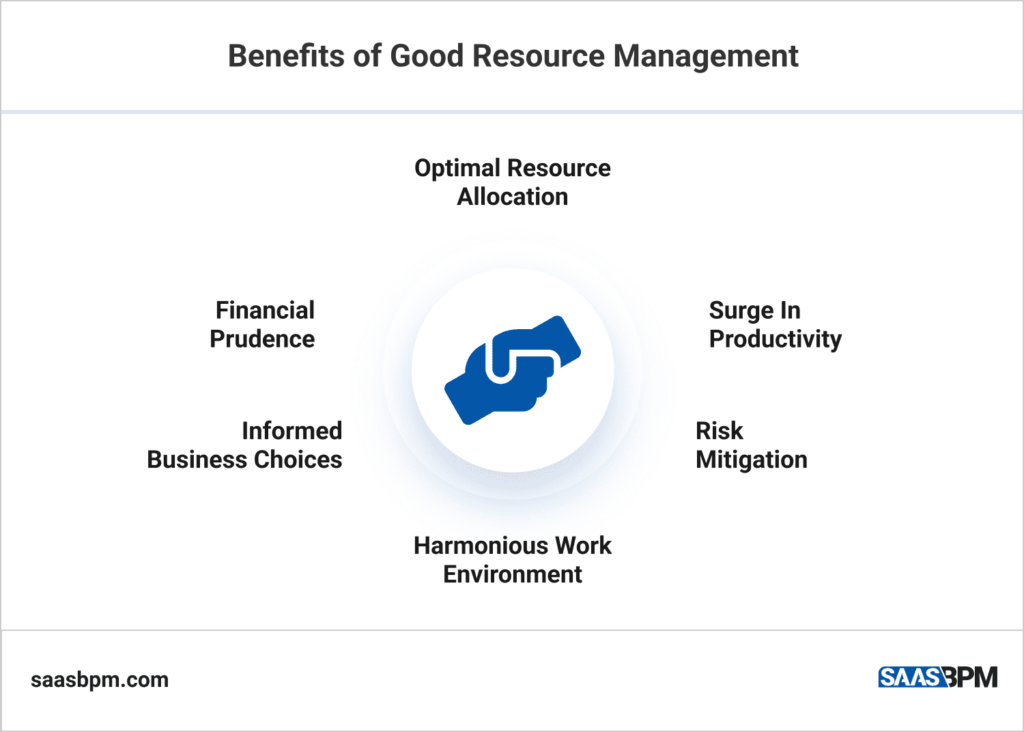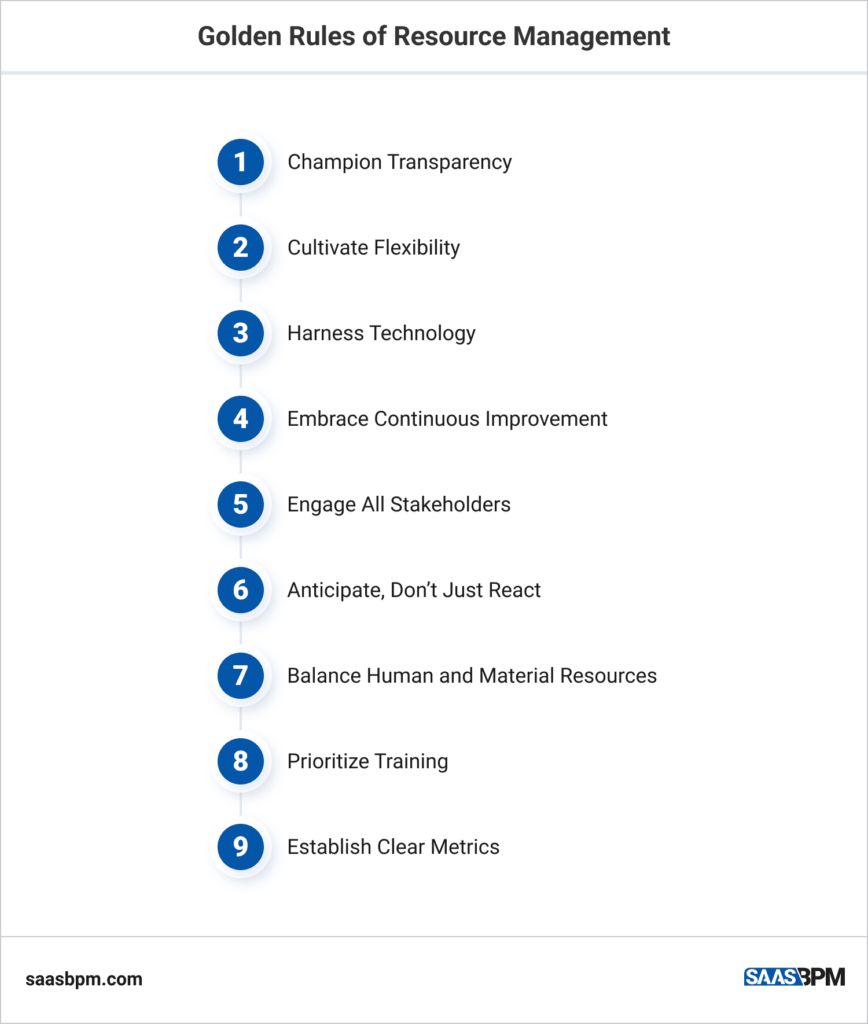The business landscape today is shaped largely by how adeptly an organization handles its resources. Resource management, intrinsically tied with business process management, is the art and science of allocating, maneuvering, and leveraging an enterprise’s assets to ensure peak efficiency and results.
This is not just about managing materials or funds; it spans across human resources, time, information, and more. In fact, 49% of agency CEOs are determined to financially prioritize talent acquisition. The path to business prosperity is often paved with exceptional resource management.
In this article, we will disperse the fog around resource management and how it can positively affect businesses. Also, we share some best practices to implement it effectively.
What Is Resource Management?
Resource management stands as the cornerstone of organizational efficiency. It involves methodically planning, allocating, and supervising the assets of a business, be they human, capital, or material. So, with an eye on the present and a vision for the future, it’s about ensuring each resource is poised for maximum impact.
Benefits of Good Resource Management

A well-orchestrated approach to managing resources can unlock a plethora of advantages for any business, propelling it to new heights of efficiency and productivity. Here are the benefits of a good resources strategy.
Optimal Resource Allocation
Every business seeks to get the most out of its available resources. Effective management ensures each asset, be it an employee’s time or a piece of machinery, is dedicated to tasks that yield the highest returns.
Financial Prudence
Good resource management inherently leads to cost benefits. By eliminating wastage and ensuring each resource is leveraged to its utmost, businesses can realize significant savings and better profit margins.
Surge in Productivity
The domino effect of streamlined resource allocation is a marked increase in productivity. When teams and tools are synchronized, workflows become smoother, leading to faster outcomes and higher quality results.
Informed Business Choices
A robust resource management framework offers granular insights into operations. This transparency empowers leaders to make decisions grounded in data, refining strategies based on tangible metrics.
Risk Mitigation
Proactively managing resources equips businesses to foresee potential challenges. This approach means less firefighting and more strategic planning, ensuring smooth project execution.
Harmonious Work Environment
Mismanaged resources often translate to overworked teams and underutilized assets. Proper resource management ensures a balanced distribution of tasks, fostering a harmonious work environment that boosts morale and reduces attrition.
Resource vs. Project Management
While both disciplines are geared towards efficiency, they operate on different spectrums. Resource management is a broad umbrella, focusing on the optimal distribution and deployment of assets across an organization. It answers the ‘what’ and ‘who’ of operations, pinpointing where each resource will deliver maximum value.
In contrast, project management delves into the specifics of ‘how’ and ‘when’. It orchestrates the sequence of tasks, ensuring projects happen within stipulated timelines and budgets. Here, resources are a component of a broader narrative, interplaying with factors like scope, milestones, and deliverables.
9 Golden Rules of Resource Management

- Champion Transparency
- Cultivate Flexibility
- Harness Technology
- Embrace Continuous Improvement
- Engage All Stakeholders
- Anticipate, Don’t Just React
- Balance Human and Material Resources
- Prioritize Training
- Establish Clear Metrics
To truly harness the potential of every asset, businesses must embrace a set of foundational rules that serve as the compass in the complex realm of resource management:
1. Champion Transparency
Clear communication forms the bedrock of effective resource management. By ensuring everyone is on the same page, you eliminate ambiguity and pave the way for cohesive action. This involves regular updates, open forums for discussion, and clarity in documenting processes and decisions.
2. Cultivate Flexibility
In a dynamic business environment, agility is an asset. Cultivating a flexible approach to resource management ensures businesses can adapt to shifting landscapes, seizing opportunities as they arise. This means being prepared for sudden changes in market conditions, resource availability, or project priorities.
3. Harness Technology
The digital age offers a plethora of tools that simplify resource management. Leveraging these can automate workflows, offer real-time insights, and enhance accuracy. From complex project management software to AI-driven forecasting tools, technology can be a game-changer.
4. Embrace Continuous Improvement
The world of business is in constant flux. A commitment to regular reviews and iterative improvements ensures your resource management strategies remain relevant and effective. This iterative approach means regularly revisiting processes, learning from past projects, and integrating feedback for improvement.
5. Engage All Stakeholders
Every individual, from frontline employees to upper management, offers a unique perspective. Engaging all stakeholders in the resource management dialogue fosters inclusivity and can unearth insights that might otherwise remain obscured. Therefore, regular stakeholder meetings and feedback sessions can provide valuable direction.
6. Anticipate, Don’t Just React

Effective resource management is as much about forecasting as it is about present allocation. Thus, developing mechanisms to anticipate future needs ensures businesses remain a step ahead, ready to tackle challenges head-on. You can achieve this through data analysis, trend spotting, and proactive communication.
7. Balance Human and Material Resources
While technology and assets are crucial, human resources remain at the heart of every operation. Moreover, striking a balance between human and material resource allocation is pivotal for holistic success. Recognizing the unique strengths and capabilities of both can lead to a smooth workflow.
8. Prioritize Training
Equipping teams with the skills to utilize resources effectively is a long-term investment. Regular training sessions ensure everyone is up to date on best practices and the latest tools. Whether it’s mastering new software, understanding industry trends, or refining soft skills, continuous learning plays a crucial role.
9. Establish Clear Metrics
What isn’t measured can’t be managed. Establishing clear KPIs about resource utilization can offer a roadmap for allocation strategies and highlight areas of improvement. Hence, through these metrics, businesses can audit performance, identify gaps, and make informed strategic decisions.
Key Takeaways
Resource management stands as the lynchpin of business success, orchestrating the symphony of human, material, and financial assets towards optimal outcomes. In fact, with its profound impact on cost, productivity, and organizational harmony, mastering its nuances can set companies on a trajectory of steady growth. By championing transparency, cultivating flexibility, and harnessing the power of technology, businesses can unlock the full potential of their resources. As we navigate the complex tapestry of today’s business environment, the golden rules of resource management serve as beacons, guiding enterprises towards excellence.

